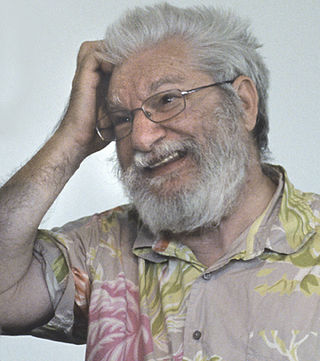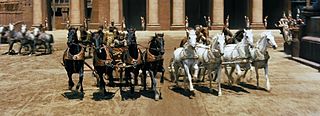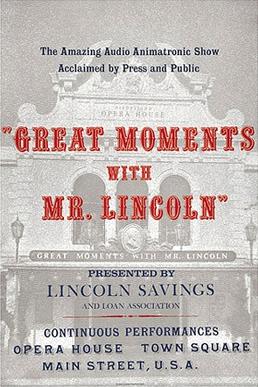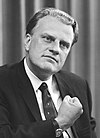
70 mm film is a wide high-resolution film gauge for motion picture photography, with a negative area nearly 3.5 times as large as the standard 35 mm motion picture film format. As used in cameras, the film is 65 mm (2.6 in) wide. For projection, the original 65 mm film is printed on 70 mm (2.8 in) film. The additional 5 mm contains the four magnetic strips, holding six tracks of stereophonic sound. Although later 70 mm prints use digital sound encoding, the vast majority of existing and surviving 70 mm prints pre-date this technology.

The 1964–1965 New York World's Fair was a world's fair that held over 140 pavilions and 110 restaurants, representing 80 nations, 24 US states, and over 45 corporations with the goal and the final result of building exhibits or attractions at Flushing Meadows–Corona Park in Queens, New York City. The immense fair covered 646 acres (2.61 km2) on half the park, with numerous pools or fountains, and an amusement park with rides near the lake. However, the fair did not receive official support or approval from the Bureau of International Expositions (BIE).

Cinerama is a widescreen process that originally projected images simultaneously from three synchronized 35mm projectors onto a huge, deeply curved screen, subtending 146-degrees of arc. The trademarked process was marketed by the Cinerama corporation. It was the first of several novel processes introduced during the 1950s when the movie industry was reacting to competition from television. Cinerama was presented to the public as a theatrical event, with reserved seating and printed programs, and audience members often dressed in their best attire for the evening.

5.1 surround sound is the common name for surround sound audio systems. 5.1 is the most commonly used layout in home theatres. It uses five full bandwidth channels and one low-frequency effects channel. Dolby Digital, Dolby Pro Logic II, DTS, SDDS, and THX are all common 5.1 systems. 5.1 is also the standard surround sound audio component of digital broadcast and music.

Around the World in 80 Days is a 1956 American epic adventure-comedy film starring David Niven, Cantinflas, Robert Newton and Shirley MacLaine, produced by the Michael Todd Company and released by United Artists.

Todd-AO is an American post-production company founded in 1953 by Mike Todd and Robert Naify, providing sound-related services to the motion picture and television industries. For more than five decades, it was the worldwide leader in theater sound. The company now operates one facility in the Los Angeles area.
World Wide Pictures (WWP) is a film distributor and production company established as a subsidiary of the Billy Graham Evangelistic Association (BGEA) in 1951. It is involved in the production and distribution of evangelistic films, the production of Graham crusade films, and publicity for Graham crusades.

Daniel Graham was an American visual artist, writer, and curator in the writer-artist tradition. In addition to his visual works, he published a large array of critical and speculative writing that spanned the spectrum from heady art theory essays, reviews of rock music, Dwight D. Eisenhower's paintings, and Dean Martin's television show. His early magazine-based art predates, but is often associated with, conceptual art. His later work focused on cultural phenomena by incorporating photography, video, performance art, glass and mirror installation art structures, and closed-circuit television. He lived and worked in New York City.
70 mm Grandeur film, also called Fox Grandeur or Grandeur 70, is a 70 mm widescreen film format developed by William Fox through his Fox Film and Fox-Case corporations and used commercially on a small but successful scale in 1929–30.
Super Technirama 70 was the marketing name for a special type of deluxe film exhibition that was most popular in the 1960s. It was the 70 mm version of the Technirama exhibition format.
Super Panavision 70 is the marketing brand name used to identify movies photographed with Panavision 70 mm spherical optics between 1959 and 1983.

Ultra Panavision 70 and MGM Camera 65 were, from 1957 to 1966, the marketing brands that identified motion pictures photographed with Panavision's anamorphic movie camera lenses on 65 mm film. Ultra Panavision 70 and MGM Camera 65 were shot at 24 frames per second (fps) using anamorphic camera lenses. Ultra Panavision 70 and MGM Camera 65's anamorphic lenses compressed the image 1.25 times, yielding an extremely wide aspect ratio of 2.76:1.

Oklahoma! is a 1955 American musical film based on the 1943 musical of the same name by Richard Rodgers and Oscar Hammerstein II, which in turn was based on the 1931 play Green Grow The Lilacs written by Lynn Riggs. It stars Gordon MacRae, Shirley Jones, Rod Steiger, Charlotte Greenwood, Gloria Grahame, Gene Nelson, James Whitmore, and Eddie Albert. The production was the only musical directed by Fred Zinnemann. Oklahoma! was the first feature film photographed in the Todd-AO 70 mm widescreen process.

South Pacific is a 1958 American romantic musical film based on the 1949 Rodgers and Hammerstein musical South Pacific, which in turn is loosely based on James A. Michener's 1947 short-story collection Tales of the South Pacific. The film, directed by Joshua Logan, stars Rossano Brazzi, Mitzi Gaynor, John Kerr and Ray Walston in the leading roles with Juanita Hall as Bloody Mary, the part that she had played in the original stage production. The film was nominated for three Academy Awards, winning the Academy Award for Best Sound for Fred Hynes. It is set in 1943, during World War II, on an island in the South Pacific.
To Be Alive! is a 1964 American short documentary film co-directed by Francis Thompson and Alexander Hammid. The film is notable for its use of a multi-screen format and for winning the Oscar for Documentary Short Subject at the 38th Academy Awards.
Canada '67 is a Circle-Vision 360° documentary film by Canadian film director Robert Barclay, which was presented at the Telephone Pavilion,, part of Expo 67, an International World's Fair held in Montreal, Quebec, Canada in 1967 to mark the centenary of the Confederation of Canada.
The Council of Churches of the City of New York (CCCNY) was established in 1815 as the Brooklyn Church and Mission Society. It is the oldest ecumenical council of churches in the United States. The council represents 1.5 million Protestants, Anglicans and Orthodox Christians. A. R. Bernard is the president of the council.












